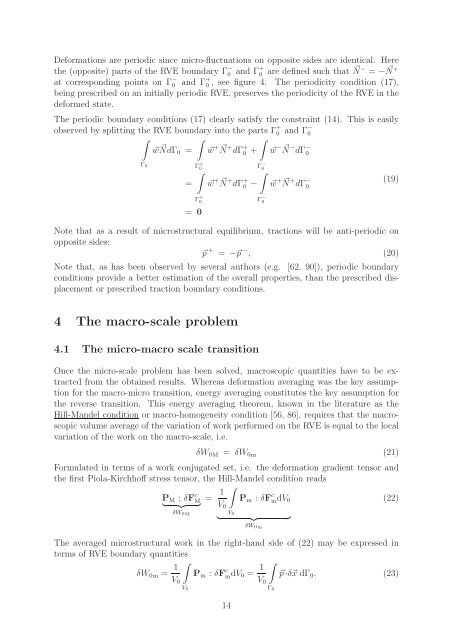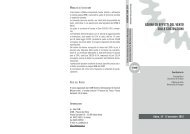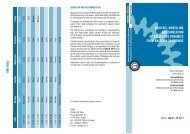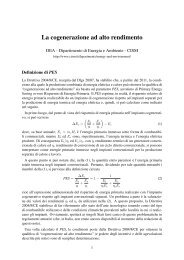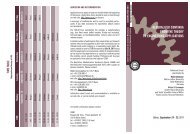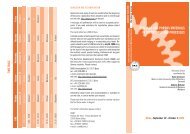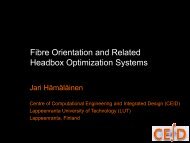Scale transitions in solid mechanics based on computational ... - Cism
Scale transitions in solid mechanics based on computational ... - Cism
Scale transitions in solid mechanics based on computational ... - Cism
- No tags were found...
Create successful ePaper yourself
Turn your PDF publications into a flip-book with our unique Google optimized e-Paper software.
Deformati<strong>on</strong>s are periodic s<str<strong>on</strong>g>in</str<strong>on</strong>g>ce micro-fluctuati<strong>on</strong>s <strong>on</strong> opposite sides are identical. Herethe (opposite) parts of the RVE boundary Γ − 0 and Γ + 0 are def<str<strong>on</strong>g>in</str<strong>on</strong>g>ed such that N ⃗ − = −N ⃗ +at corresp<strong>on</strong>d<str<strong>on</strong>g>in</str<strong>on</strong>g>g po<str<strong>on</strong>g>in</str<strong>on</strong>g>ts <strong>on</strong> Γ − 0 and Γ + 0 , see figure 4. The periodicity c<strong>on</strong>diti<strong>on</strong> (17),be<str<strong>on</strong>g>in</str<strong>on</strong>g>g prescribed <strong>on</strong> an <str<strong>on</strong>g>in</str<strong>on</strong>g>itially periodic RVE, preserves the periodicity of the RVE <str<strong>on</strong>g>in</str<strong>on</strong>g> thedeformed state.The periodic boundary c<strong>on</strong>diti<strong>on</strong>s (17) clearly satisfy the c<strong>on</strong>stra<str<strong>on</strong>g>in</str<strong>on</strong>g>t (14). This is easilyobserved by splitt<str<strong>on</strong>g>in</str<strong>on</strong>g>g the RVE boundary <str<strong>on</strong>g>in</str<strong>on</strong>g>to the parts Γ + 0 and Γ − 0∫∫∫⃗w NdΓ ⃗ 0 = ⃗w + N ⃗ + dΓ + 0 + ⃗w − N ⃗ − dΓ − 0Γ 0 Γ + 0Γ − 0∫∫= ⃗w + N ⃗ + dΓ + 0 − ⃗w + N ⃗ + dΓ − (19)0Γ + 0= 0Γ − 0Note that as a result of microstructural equilibrium, tracti<strong>on</strong>s will be anti-periodic <strong>on</strong>opposite sides:⃗p + = −⃗p − , (20)Note that, as has been observed by several authors (e.g. [62, 90]), periodic boundaryc<strong>on</strong>diti<strong>on</strong>s provide a better estimati<strong>on</strong> of the overall properties, than the prescribed displacementor prescribed tracti<strong>on</strong> boundary c<strong>on</strong>diti<strong>on</strong>s.4 The macro-scale problem4.1 The micro-macro scale transiti<strong>on</strong>Once the micro-scale problem has been solved, macroscopic quantities have to be extractedfrom the obta<str<strong>on</strong>g>in</str<strong>on</strong>g>ed results. Whereas deformati<strong>on</strong> averag<str<strong>on</strong>g>in</str<strong>on</strong>g>g was the key assumpti<strong>on</strong>for the macro-micro transiti<strong>on</strong>, energy averag<str<strong>on</strong>g>in</str<strong>on</strong>g>g c<strong>on</strong>stitutes the key assumpti<strong>on</strong> forthe reverse transiti<strong>on</strong>. This energy averag<str<strong>on</strong>g>in</str<strong>on</strong>g>g theorem, known <str<strong>on</strong>g>in</str<strong>on</strong>g> the literature as theHill-Mandel c<strong>on</strong>diti<strong>on</strong> or macro-homogeneity c<strong>on</strong>diti<strong>on</strong> [56, 86], requires that the macroscopicvolume average of the variati<strong>on</strong> of work performed <strong>on</strong> the RVE is equal to the localvariati<strong>on</strong> of the work <strong>on</strong> the macro-scale, i.e.δW 0M = δW 0m (21)Formulated <str<strong>on</strong>g>in</str<strong>on</strong>g> terms of a work c<strong>on</strong>jugated set, i.e. the deformati<strong>on</strong> gradient tensor andthe first Piola-Kirchhoff stress tensor, the Hill-Mandel c<strong>on</strong>diti<strong>on</strong> readsP M : δF c M} {{ }δW 0M= 1 V 0∫P m : δF c m dV 0(22)V}0{{ }δW 0mThe averaged microstructural work <str<strong>on</strong>g>in</str<strong>on</strong>g> the right-hand side of (22) may be expressed <str<strong>on</strong>g>in</str<strong>on</strong>g>terms of RVE boundary quantitiesδW 0m = 1 ∫P m : δF c mV dV 0 = 1 ∫⃗p ·δ⃗x dΓ 0 , (23)0 V 0Γ 0V 014


